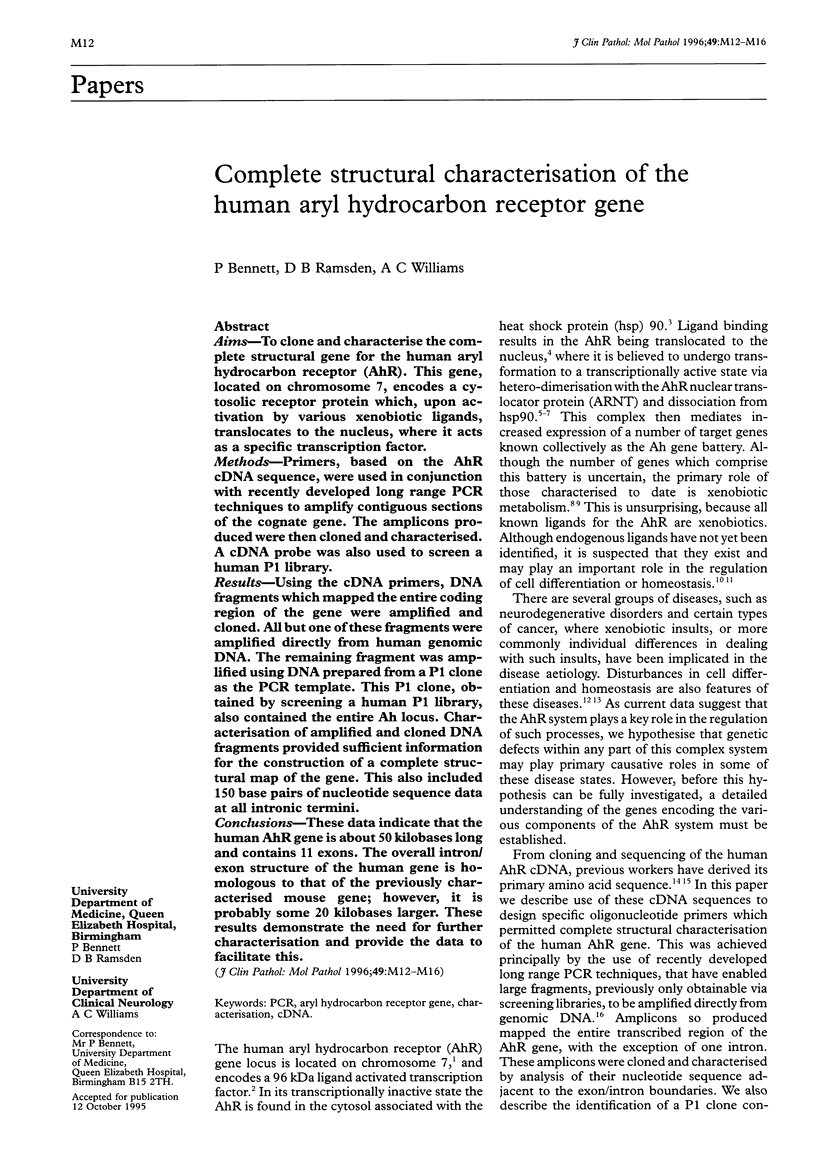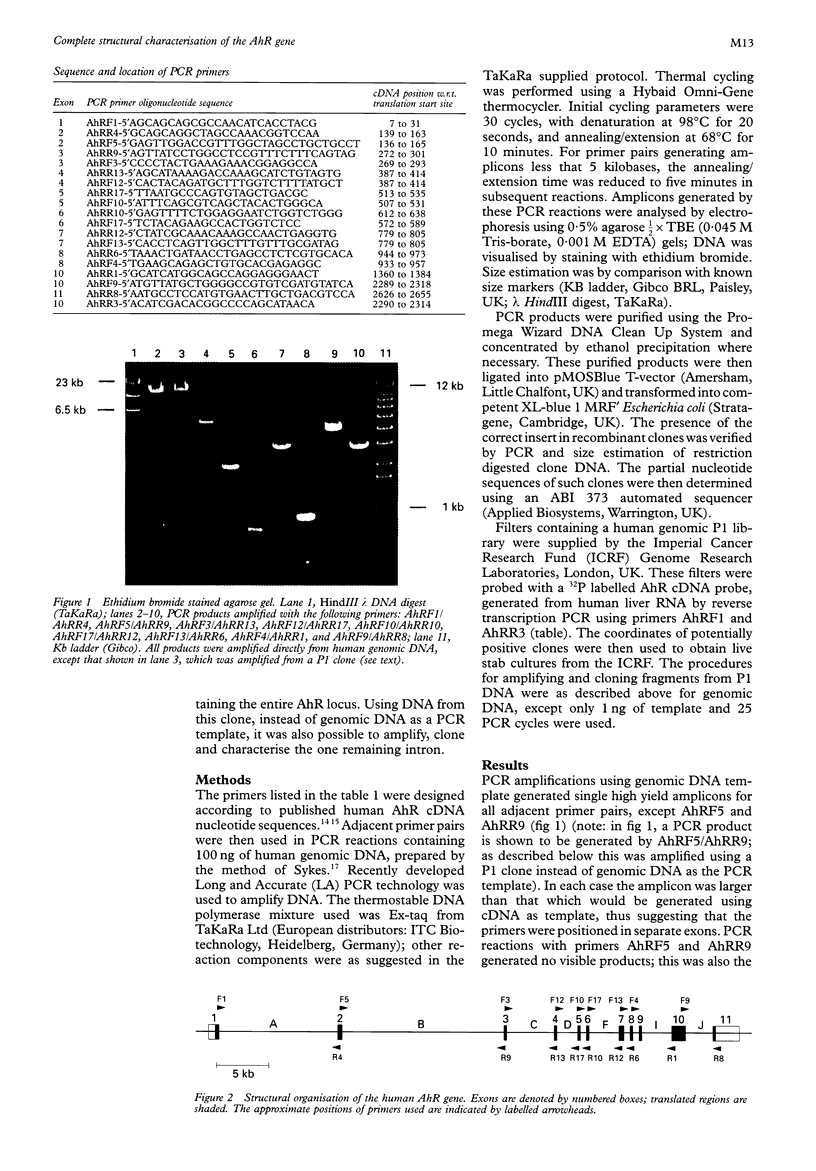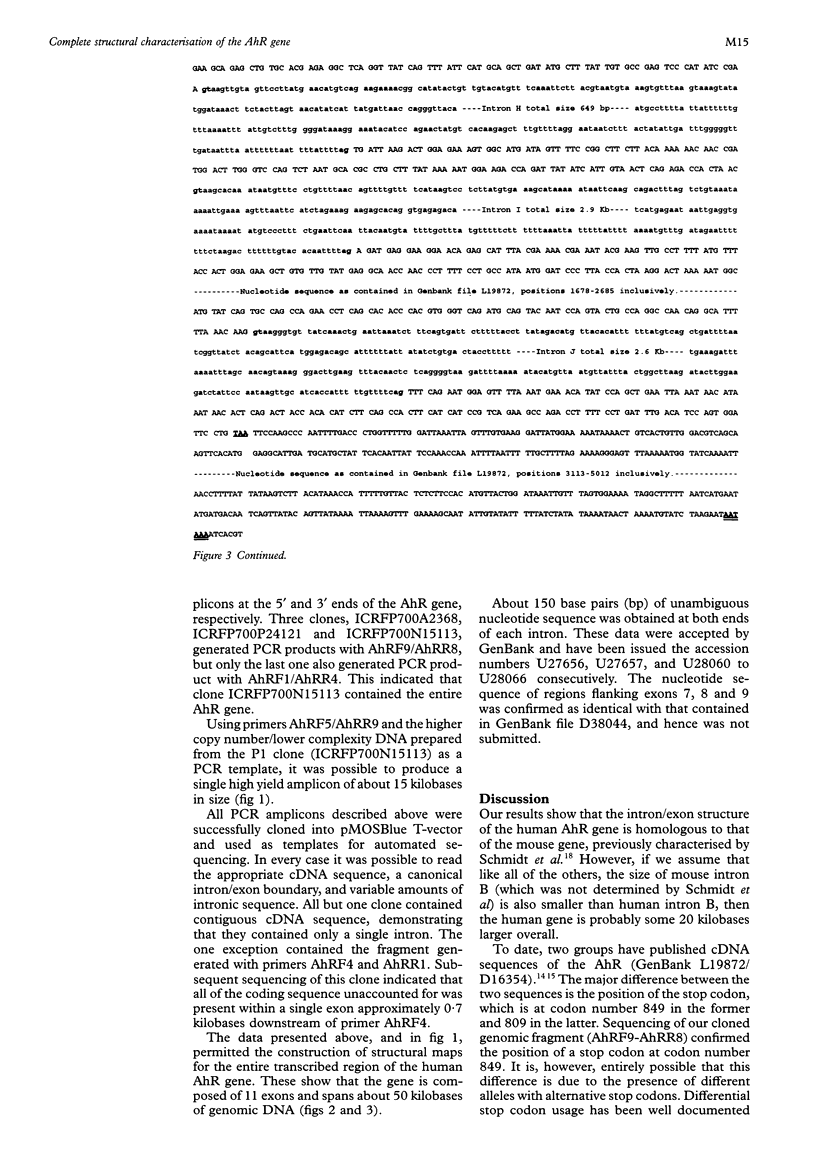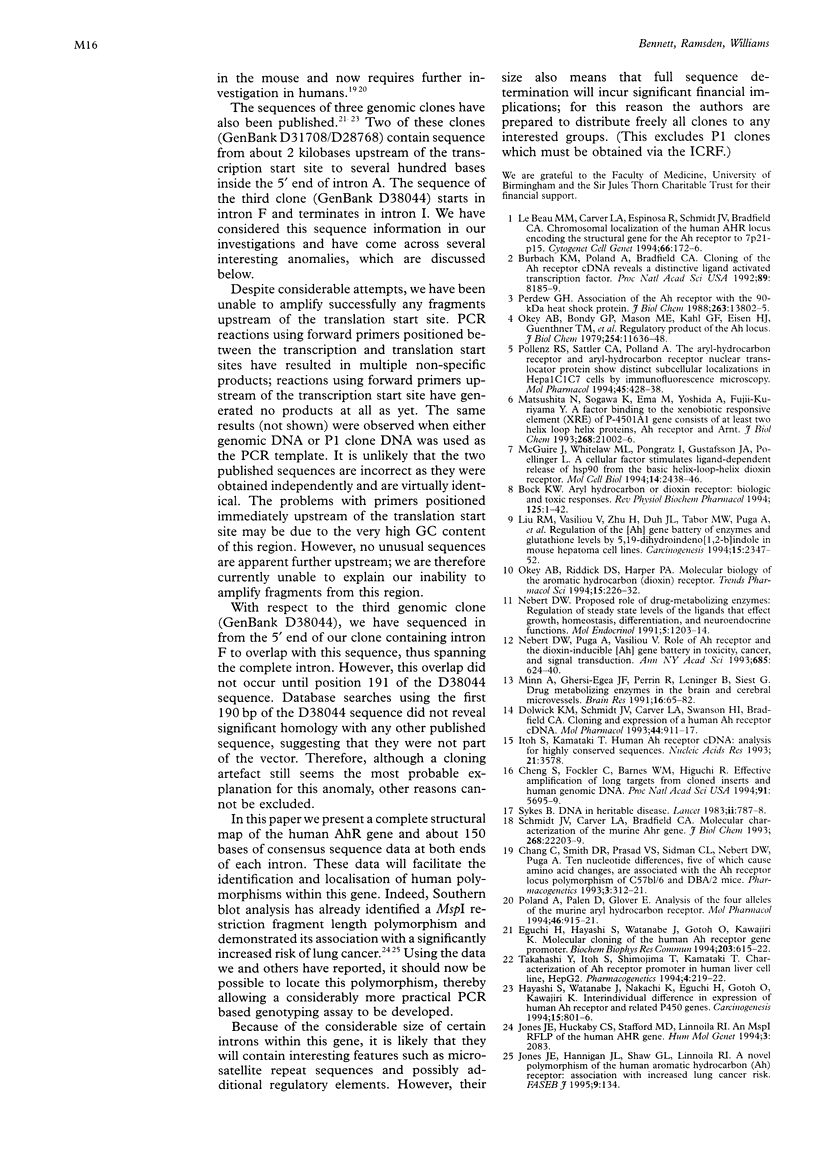Abstract
Aims—To clone and characterise the complete structural gene for the human aryl hydrocarbon receptor (AhR). This gene, located on chromosome 7, encodes a cytosolic receptor protein which, upon activation by various xenobiotic ligands, translocates to the nucleus, where it acts as a specific transcription factor.
Methods—Primers, based on the AhR cDNA sequence, were used in conjunction with recently developed long range PCR techniques to amplify contiguous sections of the cognate gene. The amplicons produced were then cloned and characterised. A cDNA probe was also used to screen a human P1 library.
Results—Using the cDNA primers, DNA fragments which mapped the entire coding region of the gene were amplified and cloned. All but one of these fragments were amplified directly from human genomic DNA. The remaining fragment was amplified using DNA prepared from a P1 clone as the PCR template. This P1 clone, obtained by screening a human P1 library, also contained the entire Ah locus. Characterisation of amplified and cloned DNA fragments provided sufficient information for the construction of a complete structural map of the gene. This also included 150 base pairs of nucleotide sequence data at all intronic termini.
Conclusions—These data indicate that the human AhR gene is about 50 kilobases long and contains 11 exons. The overall intron/exon structure of the human gene is homologous to that of the previously characterised mouse gene; however, it is probably some 20 kilobases larger. These results demonstrate the need for further characterisation and provide the data to facilitate this.
Keywords: PCR
Keywords: aryl hydrocarbon receptor gene
Keywords: characterisation
Keywords: cDNA
Full text
PDF




Images in this article
Selected References
These references are in PubMed. This may not be the complete list of references from this article.
- Bock K. W. Aryl hydrocarbon or dioxin receptor: biologic and toxic responses. Rev Physiol Biochem Pharmacol. 1994;125:1–42. doi: 10.1007/BFb0030908. [DOI] [PubMed] [Google Scholar]
- Burbach K. M., Poland A., Bradfield C. A. Cloning of the Ah-receptor cDNA reveals a distinctive ligand-activated transcription factor. Proc Natl Acad Sci U S A. 1992 Sep 1;89(17):8185–8189. doi: 10.1073/pnas.89.17.8185. [DOI] [PMC free article] [PubMed] [Google Scholar]
- Chang C., Smith D. R., Prasad V. S., Sidman C. L., Nebert D. W., Puga A. Ten nucleotide differences, five of which cause amino acid changes, are associated with the Ah receptor locus polymorphism of C57BL/6 and DBA/2 mice. Pharmacogenetics. 1993 Dec;3(6):312–321. doi: 10.1097/00008571-199312000-00005. [DOI] [PubMed] [Google Scholar]
- Dolwick K. M., Schmidt J. V., Carver L. A., Swanson H. I., Bradfield C. A. Cloning and expression of a human Ah receptor cDNA. Mol Pharmacol. 1993 Nov;44(5):911–917. [PubMed] [Google Scholar]
- Eguchi H., Hayashi S., Watanabe J., Gotoh O., Kawajiri K. Molecular cloning of the human AH receptor gene promoter. Biochem Biophys Res Commun. 1994 Aug 30;203(1):615–622. doi: 10.1006/bbrc.1994.2227. [DOI] [PubMed] [Google Scholar]
- Hayashi S., Watanabe J., Nakachi K., Eguchi H., Gotoh O., Kawajiri K. Interindividual difference in expression of human Ah receptor and related P450 genes. Carcinogenesis. 1994 May;15(5):801–806. doi: 10.1093/carcin/15.5.801. [DOI] [PubMed] [Google Scholar]
- Itoh S., Kamataki T. Human Ah receptor cDNA: analysis for highly conserved sequences. Nucleic Acids Res. 1993 Jul 25;21(15):3578–3578. doi: 10.1093/nar/21.15.3578. [DOI] [PMC free article] [PubMed] [Google Scholar]
- Jones J. E., Huckaby C. S., Stafford M. D., Linnoila R. I. An MspI RFLP of the human AHR gene. Hum Mol Genet. 1994 Nov;3(11):2083–2083. [PubMed] [Google Scholar]
- Le Beau M. M., Carver L. A., Espinosa R., 3rd, Schmidt J. V., Bradfield C. A. Chromosomal localization of the human AHR locus encoding the structural gene for the Ah receptor to 7p21-->p15. Cytogenet Cell Genet. 1994;66(3):172–176. doi: 10.1159/000133694. [DOI] [PubMed] [Google Scholar]
- Liu R. M., Vasiliou V., Zhu H., Duh J. L., Tabor M. W., Puga A., Nebert D. W., Sainsbury M., Shertzer H. G. Regulation of [Ah] gene battery enzymes and glutathione levels by 5,10-dihydroindeno[1,2-b]indole in mouse hepatoma cell lines. Carcinogenesis. 1994 Oct;15(10):2347–2352. doi: 10.1093/carcin/15.10.2347. [DOI] [PubMed] [Google Scholar]
- Matsushita N., Sogawa K., Ema M., Yoshida A., Fujii-Kuriyama Y. A factor binding to the xenobiotic responsive element (XRE) of P-4501A1 gene consists of at least two helix-loop-helix proteins, Ah receptor and Arnt. J Biol Chem. 1993 Oct 5;268(28):21002–21006. [PubMed] [Google Scholar]
- McGuire J., Whitelaw M. L., Pongratz I., Gustafsson J. A., Poellinger L. A cellular factor stimulates ligand-dependent release of hsp90 from the basic helix-loop-helix dioxin receptor. Mol Cell Biol. 1994 Apr;14(4):2438–2446. doi: 10.1128/mcb.14.4.2438. [DOI] [PMC free article] [PubMed] [Google Scholar]
- Minn A., Ghersi-Egea J. F., Perrin R., Leininger B., Siest G. Drug metabolizing enzymes in the brain and cerebral microvessels. Brain Res Brain Res Rev. 1991 Jan-Apr;16(1):65–82. doi: 10.1016/0165-0173(91)90020-9. [DOI] [PubMed] [Google Scholar]
- Nebert D. W. Proposed role of drug-metabolizing enzymes: regulation of steady state levels of the ligands that effect growth, homeostasis, differentiation, and neuroendocrine functions. Mol Endocrinol. 1991 Sep;5(9):1203–1214. doi: 10.1210/mend-5-9-1203. [DOI] [PubMed] [Google Scholar]
- Nebert D. W., Puga A., Vasiliou V. Role of the Ah receptor and the dioxin-inducible [Ah] gene battery in toxicity, cancer, and signal transduction. Ann N Y Acad Sci. 1993 Jun 23;685:624–640. doi: 10.1111/j.1749-6632.1993.tb35928.x. [DOI] [PubMed] [Google Scholar]
- Okey A. B., Bondy G. P., Mason M. E., Kahl G. F., Eisen H. J., Guenthner T. M., Nebert D. W. Regulatory gene product of the Ah locus. Characterization of the cytosolic inducer-receptor complex and evidence for its nuclear translocation. J Biol Chem. 1979 Nov 25;254(22):11636–11648. [PubMed] [Google Scholar]
- Okey A. B., Riddick D. S., Harper P. A. Molecular biology of the aromatic hydrocarbon (dioxin) receptor. Trends Pharmacol Sci. 1994 Jul;15(7):226–232. doi: 10.1016/0165-6147(94)90316-6. [DOI] [PubMed] [Google Scholar]
- Perdew G. H. Association of the Ah receptor with the 90-kDa heat shock protein. J Biol Chem. 1988 Sep 25;263(27):13802–13805. [PubMed] [Google Scholar]
- Poland A., Palen D., Glover E. Analysis of the four alleles of the murine aryl hydrocarbon receptor. Mol Pharmacol. 1994 Nov;46(5):915–921. [PubMed] [Google Scholar]
- Pollenz R. S., Sattler C. A., Poland A. The aryl hydrocarbon receptor and aryl hydrocarbon receptor nuclear translocator protein show distinct subcellular localizations in Hepa 1c1c7 cells by immunofluorescence microscopy. Mol Pharmacol. 1994 Mar;45(3):428–438. [PubMed] [Google Scholar]
- Schmidt J. V., Carver L. A., Bradfield C. A. Molecular characterization of the murine Ahr gene. Organization, promoter analysis, and chromosomal assignment. J Biol Chem. 1993 Oct 15;268(29):22203–22209. [PubMed] [Google Scholar]
- Takahashi Y., Itoh S., Shimojima T., Kamataki T. Characterization of Ah receptor promoter in human liver cell line, HepG2. Pharmacogenetics. 1994 Aug;4(4):219–222. doi: 10.1097/00008571-199408000-00006. [DOI] [PubMed] [Google Scholar]



